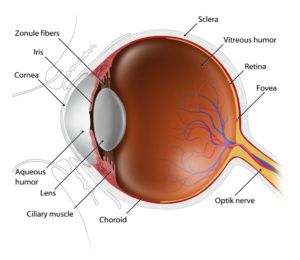How do we see?
Your eyes are as unique as you, which is why everyone’s prescription is different from the person next to them. You hear all the terms – short-sighted, long-sighted, astigmatism – but what does it mean? In this section, we’ll explain how your eyes focus and what your prescription means.
How do we focus?
Firstly, it’s helpful to know how our eyes see images. The eye itself is much like a camera – light passes through the eye, focused by different natural lenses to hit photosensitive tissue at the back of the eye, which converts the images into electrical signals to send to the brain.
In order to see clearly, the images at the retina (the light-sensitive tissue at the back of the eye) must be in focus; much like a camera needs to be in focus to take clear photos. This is achieved by the cornea and the natural lens. While the cornea, the clear tissue on the front of the eye, is a non-adjustable, high powered lens, the lens inside the eye changes power to focus on objects near or far away, as muscles pull on the lens fibres to change it’s shape. This light comes into a sharp focus onto our retina, which interprets the light signals and sends it on a complex path through our optic nerves to the visual cortex at the back of our brains, where it recognises objects, faces, everything!

Short-sightedness/Myopia
Myopia is when the eyes see close-up objects clearly, but objects far away are blurry. It occurs when the eyeball is too long or, rarely, the cornea is too curved. Because of this, light rays focus in front of the retina instead of on the retina, needing minus-powered lenses to push the image back to focus on the retina. For example, reading a book is no trouble, but reading distant road signs while driving is difficult for someone with short-sightedness.
While myopia might seem harmless, it usually begins during childhood, when the eye is susceptible to growing to large lengths, leading to high myopia. High myopia increases your chances of developing other conditions such as retinal detachment, cataracts, and glaucoma, which are sight-threatening. Fortunately, there are many interventions these days to stop children’s myopia progressing to high levels, which is why early eye exams for children are so important to detect both early and ongoing signs of myopia and other eye conditions.
Long-sightedness/Hyperopia
Hyperopia is a little more complex as it can manifest in different ways! Hyperopia occurs when the eye does not bend light correctly and this results in light rays focusing behind the retina instead of directly on it, since the eyeball is shorter or the cornea is flatter than normal. The eyes may see both distance and near clearly, just distance clearly and blur at near, or nothing clearly at all, depending on the age of the focusing system and the degree of long-sightedness. It requires plus-powered lenses to bring the image forward to focus on the retina.
Many children are born with hyperopia, but they grow out of it as their eyeball lengthens, however, some children’s eyeballs never grow to the normally rounded shape. This results in blurred vision, eyestrain, fatigue or headaches from doing close and squinting the eyes. A comprehensive eye test can detect hyperopia, which can be corrected with spectacle lenses or contact lenses.
Astigmatism
Astigmatism is caused by an irregularly shaped cornea, which causes light to refract or bend incorrectly within your eye. This bend prevents the light from correctly focusing on the retina, which often results in blurred or double vision. Astigmatism is a unique refractive error because it can be present in people with myopia, hyperopia and presbyopia, and it affects people of all ages. Blurriness from astigmatism can range from a small fuzz around text to high levels of distortion. In severe cases, astigmatism can make simple visual tasks like watching TV or reading a text message nearly impossible. Even if you don’t need glasses for a small amount of astigmatism, remember, your eyes can change and astigmatism can worsen, so regular eye exams are still essential. The good news is there are many options to restore your vision. A comprehensive eye test will quickly determine if you have astigmatism, and if so, the best corrective method to accommodate your lifestyle.
Presbyopia
Presbyopia is part of the natural aging process for everyone. After the age of 40, people find it harder to focus on nearby objects, which can progressively worsen until about the age of 60. Presbyopia occurs when the lens inside the eye becomes thickened and hardened after a life-time of UV exposure, losing the flexibility which allows us to change focus to see at different distances. Since the lens struggles to adjust focusing power, we find it difficult to see near objects, like books or phones, clearly. As we age, these fibres of the clear lens not only become more rigid, but opaque too, which is known as “cataracts”. Trying to read a menu in a dim-lit restaurant is a nightmare for anyone with presbyopia, but fortunately, there are many spectacle and contact lens options available to suit you!







